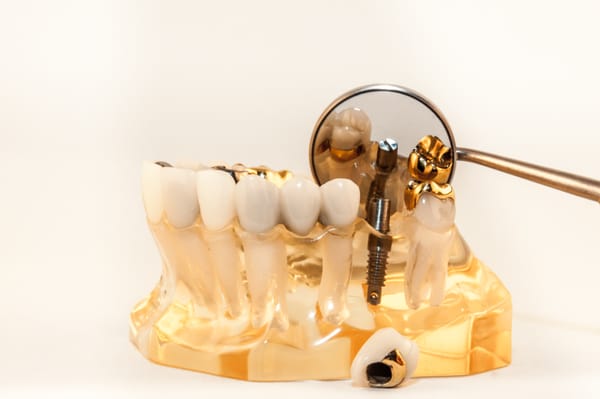The porcelain fused to metal crown, or PFM, is the most common type of crown for damaged teeth. This type of tooth restoration has been used for decades and is a durable, long-term solution for missing or damaged teeth. While prosthodontists specialize in tooth replacement, some PFM crowns can be fit and placed by general dentists. This guide will explore the uses, advantages, and cost of a porcelain fused to metal crown.
What Is a PFM Crown?
A porcelain fused to metal crown has a metal shell with a veneer of porcelain fused to it. The metal of the crown provides strength for a durable restoration that avoids cracks and breaks. This metal shell also bonds to teeth easier for a more comfortable and secure fit. Some patients are unable to use PFM crown due to metal allergies, and in these cases, an all porcelain crown may be necessary.
The porcelain over the metal shell provides a natural-looking white color that can be color-matched to existing teeth for a realistic appearance. The lasting strength and natural-looking color of the crown are why PFM crowns are most popular, and why many insurance companies offer partial coverage for the restoration.

When Is a Porcelain Fused to Metal Crown Used?
PFM crowns are used when the original tooth is missing or is damaged beyond surface repair, such as a filling for a cavity. In the case of a missing tooth, a dental implant may be necessary prior to the placement of the PFM crown, or the PFM crown may serve as an abutment for a bridge that will replace multiple teeth. Sometimes, a root canal is necessary for nerve treatment of a tooth, and the PFM crown will be the final step after the tooth is capped to cover the nerve endings.
What Is the Cost of a PFM?
All dental procedures can be expensive, so it is important to understand as much as possible about them before purchasing and beginning treatment. The porcelain fused to metal crown cost typically ranges from $1,000 to $3,000 per tooth.
This expense is for the PFM crown only, and does not include any dental work that may be needed prior to the PFM crown placement. For example, a patient who needs a root canal or a dental implant first will pay up to $3,000 for the first treatment before the PFM crown is placed, which is the final step of the dental restoration work.
Dental insurance and dental savings plans can be helpful in reducing the cost of a PFM crown. For example, dental insurance and savings plans may have lower thresholds on allowable charges and fees by dentists, or they may cover a portion of the PFM crown cost, making the overall financial liability between 20% and 60% lower compared to having to pay the full expense.
In addition to the PFM cost, your dentist may charge other fees such as office visits, X-rays, and laboratory fees. If your dental restoration requires the expertise of a prosthodontist, the cost will be about 20% more compared to PFM crowns placed by general dentists. It is important to discuss full treatment options and ask for a full accounting of all charges before beginning treatment.
What Are the Advantages of a PFM?
When determining the type of crown for your dental restoration, it is best to discuss with your dentist and compare the all porcelain crown vs porcelain fused to metal crown. Porcelain fused to metal crowns have some distinct advantages over all porcelain crowns, including cost, durability, and future tooth comfort.
The most obvious advantage is the strength of a PFM. While porcelain is durable and has been used in teeth restoration for decades, the metal shell of a PFM crown provides added strength that cannot be matched by porcelain alone.
The amount of reduction of the tooth necessary for a PFM crown is lower compared to an all porcelain crown. This means more of the tooth is preserved with a PFM crown, reducing the risk of further damage to the original tooth and nerve structures.
Another advantage of the PFM crown is the reduced risk of future tooth sensitivity. Those with all porcelain crowns may experience more sensitivity to hot and cold temperatures, in food, drink, and weather, due to the absence of the metal shell that provides an additional barrier to the tooth’s nerve endings. Additionally, extreme temperatures in food and drink may cause cracks in the all porcelain crown, requiring additional treatment and a new crown.
Cost is another advantage of the PFM crown. An all porcelain crown uses more porcelain material, which is more expensive than the metal shell of the PFM crown. This additional porcelain increases the overall price. Additionally, many dental insurance companies provide a lower benefit for coverage of the all porcelain crown, or may not cover the cost at all when a PFM crown can be used.
Conclusion
A porcelain fused to metal crown, or PFM, offers durability and an aesthetically pleasing solution to missing and damaged teeth. PFM crowns have been successfully used for decades, and dental insurance companies typically offer partial coverage of the restoration expense.
The popularity of PFM crowns has made them a common treatment provided by general dentists; however, some patients and situations will require the expertise of a prosthodontist specialist. PFM crowns offer many advantages over all porcelain crowns, including cost, durability, and reduced tooth sensitivity following treatment.
Recommended Read: Porcelain Veneers – Procedure, Costs, and Risks

Leave a Comment